The Fast Get Faster: Hypersonics and 3D Printing
Velo3D, Lockheed Martin and Vibrant team up with DoD's LIFT Institute on a data-driven approach to certifying materials and methods for additively manufactured aerospace systems.
In the defense industry, there has been a recent and urgent need to advance aerospace applications. Global competitors are accelerating efforts to develop propulsion systems that can generate thrust to propel aerosystems at extremely high speeds. Supersonic (above Mach 1, the speed of sound) and even hypersonic (above Mach 5) flight vehicles and missiles are becoming more of a reality.
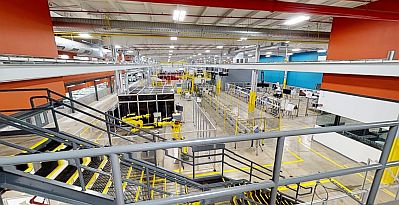
LIFT is one of 17 manufacturing innovation institutes across the country (sponsored by either the DoD, Department of Energy, or the Department of Commerce) aimed at scaling new technologies into commercialization. [Image courtesy LIFT]
This is an arena in which 3D printing is now seen as a technology that can deliver complex, single-piece engine designs at significantly lighter weights and in less time than conventional manufacturing. Materials development is advancing concurrently, with frequent news of newly certified, high-performance metal alloys for use in specific additive manufacturing (AM) provider's systems.
No matter what an advanced engine is printed out of, the ultimate proof of value is its ability to operate effectively under the extreme environmental conditions produced in hypersonic flight, performing as expected from takeoff to target. While "build and break" prototyping has an ongoing role to play in achieving these goals, the U.S. Department of Defense is also being very deliberate about doing its due diligence on AM from the ground up -- starting with a deep focus on materials science and manufacturing.
Public, Private Partnership with an Eye to the Sky
An outstanding example of this is happening at LIFT, a nonprofit public-private partnership between the DoD, industry and academia. It is operated by the American Lightweight Materials Manufacturing Innovation Institute and housed in a 100,000-square-foot facility in Detroit, Michigan.
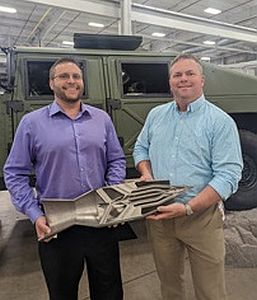
John Keogh, technical lead, and project manager Brad Friend hold a cut section of the LIFT Hypersonic Challenge 3D-printed ramjet. [Image courtesy LIFT]
Among the more-than-50 active projects currently under contract at the nine-year-old Detroit Institute are some that are participating in a "Hypersonics Challenge" funded by the DoD's Manufacturing Technology Program, overseen by the Office of the Under Secretary of Defense for Research and Engineering.
The goal is to identify which materials and/or manufacturing processes can provide the most efficient, productive pathways to vehicles and/or missiles capable of hypersonic flight. Dr. John Keogh, LIFT's Engineering Director, is responsible for the "High-Bay" virtual tour materials development area within the LIFT facility. Together with his counterpart, Dr. Amberlee Haselhuhn, Director for Materials & ICME, they lead the engineering division at LIFT.
Dr. Keogh and Dr. Haselhuhn have technical oversight of a number of R&D teams, by way of internal project oversight as well as external team projects. One of the Hypersonics Challenge projects, an external team effort for which Lockheed Martin was the industry prime and team lead, has now concluded the first phase of a study of a 3D-printed ramjet engine.
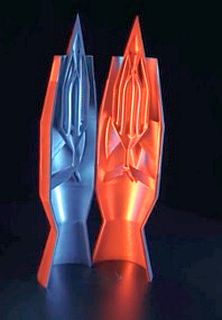
Cut view of ramjet; all features were 3D printed in one AM build. [Image courtesy Velo3D]
Dr. Keogh served as the LIFT technical lead for this project. His background is an excellent fit for the integrated multiphysics challenges of materials and process development, AM and hypersonics. He earned his doctorate in analytical chemistry with a minor focus in physical chemistry, worked in academia for 15 years, then switched to the real-world excitement of engineering, where "it's been a great road ever since," he says.
"When you're traveling at Mach 5 or above, you have very high heating at the leading edges," Keogh notes. "Sharp radii are particularly bad and lead to incredible heating, which is why reentry vehicles from space have reasonably wide radii. But hypersonic vehicles need some semblance of a leading edge for aerodynamic purposes -- and there are incredible forces that are compounding and dynamic at hypersonic speeds. It's a confluence of aerodynamics, mechanics, thermal management, and chemistry that leads to all kinds of interesting and overlapping challenges that are fun to address. And you have to work with extremely high-temperature materials that survive these environments."
Capturing Data While Printing a Ramjet
For the ramjet project, the team's intention was to identify what data streams they could collect during the laser powder bed fusion (LPBF) build of a ramjet engine printed with Inconel 718 metal alloy -- and then go through a well-established Design of Experiments to interrogate those data streams; Lockheed Martin established the quality assurance verification approach used in the project.
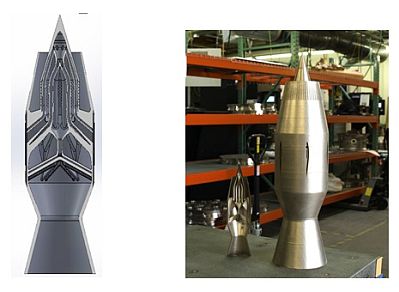
CAD design of the ramjet (left), ready for additive manufacturing, and the final version (right) of the ramjet after 3D printing. [Images courtesy Velo3D]
"AM is a relatively new manufacturing process and there's a need to validate and certify parts for service and mission-critical applications," says Keogh. "We need a data-driven approach to test and certify components right out of a printer, as opposed to a statistically driven one where you have to build multiple parts first and only then gather statistical performance data (make-and-break). Our goal was to identify the signatures of physical quality found in process data and rapid post-process inspection for accurately certifying a component for the rigors of hypersonic flight."
The LPBF system used to print the ramjet was a Velo3D Sapphire 1 MZ, which is capable of printing objects up to one meter in height (the final ramjet version is 751 millimeters tall). Every Sapphire system contains hundreds of sensors that monitor, report and save metrics throughout each build. "Velo3D's machine collects an immense amount of data," says Keogh. "It also provides a very generous build envelope oriented towards volume manufacturing."
Two ramjets were printed, along with a variety of material test coupons affectionately named for having shapes like "dog bones" (larger at both ends for tensile pull-testing) and "detergent pacs" (for density and surface finish evaluation).
Student Project Gets an "A" -- and then AM
The ramjet design itself has an interesting backstory. Rather than being created by a major aerospace company, it was originally dreamed up by an undergraduate aerospace engineering student at Purdue as a classroom assignment to improve the performance of an existing engine design.
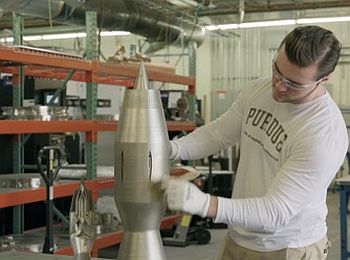
Creator meets creation: former engineering student Jay Blake, now on the aerospace applications team at Velo3D, cleaning the ramjet after 3D printing. He came up with its original design as part of an undergraduate course assignment. [Image courtesy Velo3D]
Jay Blake's homework project was inspired by the J-58 turbojet used on the SR-71 Blackbird (which, as of mid-2023, still holds a 1976 record as the fastest -- Mach 3.2 -- supersonic air-breathing manned aircraft). "My thought was that, using 3D printing, you could incorporate the volume of the inlet spike of a ramjet into the turbojet, to act as a heat exchanger to warm the fuel so it combusts more efficiently," Blake says. "The early ramjets had hundreds of different parts -- injectors, struts, internal details -- that required welding and brazing and took months to produce; my design idea was to consolidate all those parts into one so it could be printed in a matter of days." He got an 'A' on his design -- but then put it aside in sketch form while completing his studies.
Serendipitously, several years after finishing his degree, Blake began working for Velo3D on aerospace applications for additive manufacturing. "I suddenly realized my ramjet idea could actually become a real thing," he says. "That's when I finally finished my original model, using the more advanced digital software tools that were now available to me."
Velo3D then printed a scaled-down version of Blake's ramjet. No support material was needed, due to Velo3D's Intelligent Fusion and the Sapphire's patented recoater technology: after each layer of powder is laid down, the blade that normalizes it is closely followed by a vacuum that picks up excess powder and leaves behind a perfect powder layer. This creates free space between the blade and the part, eliminating the risk of a collision as the part grows (as well as the need for supports, which are traditionally used to achieve the same goal).
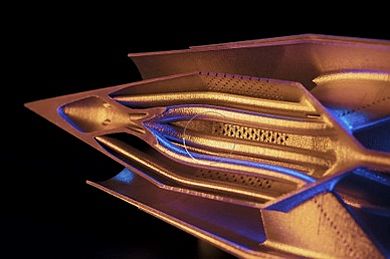
Close up of cut ramjet shows complexity of internal features. [Image courtesy Velo3D]
This advanced AM technology also produces a better surface finish at shallow angles; in the ramjet design, these angles were as low as 30 degrees. "It's a very tricky geometry," says Blake. "There are extremely thin walls at that aggressive angle, and those surfaces are perforated with 500-micron holes. There are also steep overhangs and a lot of added dimensions of complexity. Yet the first time we sent it to the printer it came out perfectly, without issue."
Big Aerospace Takes Notice
Aerospace manufacturer and Velo3D customer Lockheed Martin was shown a printed, scaled-down ramjet and wanted to learn more about AM's potential to create single-piece engine geometries. While the original design was intended to be incorporated into a supersonic, not hypersonic, jet engine, a few additional tweaks could easily morph it into a scramjet (supersonic combustion ramjet).
A scramjet can be thought of as a ramjet engine with adjustments in the design of the inlet and outlet nozzle that keep airflow speeds higher through the engine, with combustion occurring supersonically in the burner. Scramjet-powered vehicles can theoretically reach hypersonic velocities well in excess of Mach 5.
VIDEO: Velo3D Ramjet NSI Scan
In a ramjet, which has very few moving parts but an extremely complex interior structure, high pressure is produced by "ramming" external air into the combustor using the forward speed of whatever aircraft is carrying it. This is in contrast to the more common turbojet, where a compressor is used to mechanically compress the air prior to combustion. In a ramjet, this compression occurs through a series of shock waves. These shock waves and the engine geometry compress and decelerate the air until it becomes subsonic (below Mach 1) in the combustor section.
Lockheed Martin collaborated with Velo3D and LIFT to support the team's research into the maturity of metal AM for such applications, as well as the fidelity of the materials being used for it. "Obviously my design doesn't have any ITAR-controlled geometry in it so it made a great demonstration piece for AM," says Blake. "You can do all the necessary assessment on the metallurgy and structure and the 3D printing process -- without having to deal with the limitations of ITAR and export control."
Identifying Echoes of Quality with Resonance Testing
The team had a variety of "dog bones," "detergent pacs" and other test articles printed on several different Sapphire AM systems. "The goal was to assess laser-to-laser, build-to-build, part-to-part, and machine-to-machine variability, and to identify that variability through in-situ monitoring, rapid non-destructive evaluation, and stat fusion methods," says Keogh.
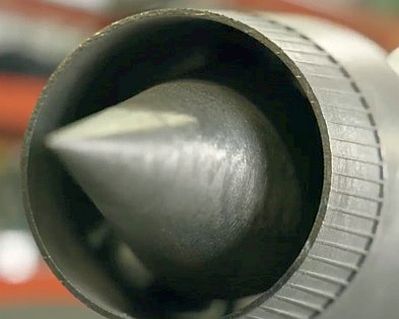
Closeup of intake end of ramjet. [Image courtesy Velo3D]
With completed ramjets and some accessory parts in hand, the hunt began to determine specific "echoes of quality" that would tell whether a finished part was a good one. "Echoes" is an appropriate word here, because the primary method of assessment the engineers chose was based on acoustics: Process-Compensated Resonance Testing (PCRT) from a company called Vibrant.
PCRT uses ultrasonic frequencies (in this case, between 5 and 500 kHz) to excite the vibrational modes of a part or component for just a few seconds or minutes. The natural resonance frequencies of the part, which are unique to both its individual geometry and its material properties, are recorded, saved and analyzed. Resonance fingerprints will depart from nominal values as a reflection of stress state, part integrity, geometry and even surface finish; for example, a component with invisible interior cracks will have significantly different resonances than an un-cracked one.
"This is a very attractive approach to couple with and complement additive manufacturing because it's volumetric, rapid, and it doesn't require destructive testing," says Keogh. "It can provide indications of porosity, surface defects, aberration in the geometry and so forth. As an example, there was a population of 'dog bones' that were slightly shorter than the others and that showed up very clearly in the resonance spectra."
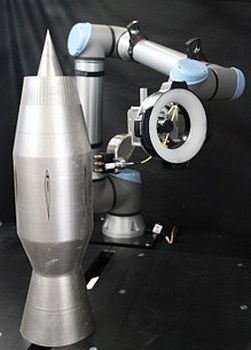
Vibrant REX PCRT system measuring resonance response of Ramjet. The REX platform enables additive manufacturers to measure a wide variety of part geometries with a single robotic test system. [Image courtesy Vibrant]
Vibrant says that PCRT measurements can potentially be correlated to energy density and scanning-speed settings, raw material properties and sourcing, build position, cooling rates, post-processing methods like hot-isostatic-pressing and residual stress -- essentially any process parameter affecting material state and mechanical properties.
This can be particularly valuable for AM process-control monitoring over time when builds of identical parts are done in large batches over many months. As each part's resonance values are captured at different frequencies, then plotted out and compared against the others, top-quality parts' metrics will coalesce around the same values; outliers will literally stand out from the crowd in the graph and be easily identified. This enables confidence-limit boundaries to be determined, provides feedback that promotes manufacturing consistency and ensures final product quality from batch to batch.
The Data are in
As a follow-on to PCRT, the LIFT team is interested in developing predictive models to identify the principal contributors to why a resonance frequency and amplitude might change and shift, and what that indicates about the quality of a 3D-printed part. "The idea is that you couple all the post-build data, which is now an objective representation of quality, and you relate that back to the data streams that you collected," Keogh says. "You apply machine learning and other data-fusion approaches to really start teasing out what are the right ways to interrogate those data streams and begin to pick out indications of quality."
The group also tried several other approaches to component inspection, including CT scanning. They even knowingly created "good processes" and "bad" ones to see if their methodologies could distinguish the two. In one instance, some ducting elbow parts were inadvertently mixed up after printing -- and the data alone was able to tell the researchers which was which.
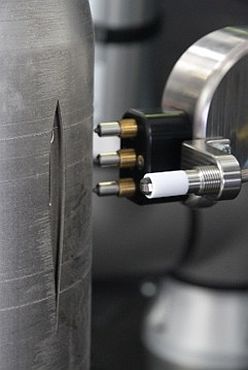
Close-up view of PCRT Transducers and thermocouple. [Image courtesy Vibrant]
"When it all backed out, it was a very successful program," says Keogh. "I was thoroughly impressed by the whole body of work. The team of Velo, Lockheed Martin and Vibrant formed a powerful group of partners who are probably some of the closest -- if not the closest -- to solving this problem of qualification and validation or certification of AM components for mission-critical and safety-critical applications. We now have populations of data that are quite impressive and highly discerning between, say, different lasers or different build features and certain indications of quality. I was honored to be the LIFT tech lead on this program because it was very heartening to see it succeed."
Next Hypersonic Flight Plans
Team stakeholders are hoping to move soon to a next-phase of the research that would consider the fatigue behavior of AM components and move toward "born-certified" parts. "We want to see hypersonic components born right out of the machine that are already certified by way of the data stream we've captured to back it up," Keogh says.
"At LIFT we're perfectly situated between industry, laboratories and government to be an extended workbench where people can come to buy-down risk with us."
Just announced this Spring was a related LIFT initiative: sponsored research by undergraduate teams at Michigan Technological University to develop new materials and "road maps" for hypersonics applications. Considering the progress made by the LIFT ramjet project, it's clear that students' ideas can be worth paying attention to!
Want more information? Click below.
Rate this article
View our terms of use and privacy policy ::m::